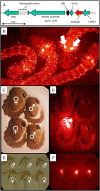Female-specific flightless phenotype for mosquito control
- PMID: 20176967
- PMCID: PMC2826341
- DOI: 10.1073/pnas.1000251107
Female-specific flightless phenotype for mosquito control
Erratum in
- Proc Natl Acad Sci U S A. 2010 Oct 26;107(43):18741
Abstract
Dengue and dengue hemorrhagic fever are increasing public health problems with an estimated 50-100 million new infections each year. Aedes aegypti is the major vector of dengue viruses in its range and control of this mosquito would reduce significantly human morbidity and mortality. Present mosquito control methods are not sufficiently effective and new approaches are needed urgently. A "sterile-male-release" strategy based on the release of mosquitoes carrying a conditional dominant lethal gene is an attractive new control methodology. Transgenic strains of Aedes aegypti were engineered to have a repressible female-specific flightless phenotype using either two separate transgenes or a single transgene, based on the use of a female-specific indirect flight muscle promoter from the Aedes aegypti Actin-4 gene. These strains eliminate the need for sterilization by irradiation, permit male-only release ("genetic sexing"), and enable the release of eggs instead of adults. Furthermore, these strains are expected to facilitate area-wide control or elimination of dengue if adopted as part of an integrated pest management strategy.
Conflict of interest statement
The authors declare no conflict of interest.
Figures


Similar articles
-
Genetic elimination of dengue vector mosquitoes.Proc Natl Acad Sci U S A. 2011 Mar 22;108(12):4772-5. doi: 10.1073/pnas.1019295108. Epub 2011 Mar 7. Proc Natl Acad Sci U S A. 2011. PMID: 21383140 Free PMC article.
-
Female-specific flightless (fsRIDL) phenotype for control of Aedes albopictus.PLoS Negl Trop Dis. 2012;6(7):e1724. doi: 10.1371/journal.pntd.0001724. Epub 2012 Jul 10. PLoS Negl Trop Dis. 2012. PMID: 22802980 Free PMC article.
-
Modelling Aedes aegypti mosquito control via transgenic and sterile insect techniques: endemics and emerging outbreaks.J Theor Biol. 2013 Aug 21;331:78-90. doi: 10.1016/j.jtbi.2013.04.014. Epub 2013 Apr 19. J Theor Biol. 2013. PMID: 23608633
-
Molecular tools to create new strains for mosquito sexing and vector control.Parasit Vectors. 2018 Dec 24;11(Suppl 2):645. doi: 10.1186/s13071-018-3209-6. Parasit Vectors. 2018. PMID: 30583736 Free PMC article. Review.
-
Population genetic structure of Aedes aegypti, the principal vector of dengue viruses.Infect Genet Evol. 2011 Mar;11(2):253-61. doi: 10.1016/j.meegid.2010.11.020. Epub 2010 Dec 15. Infect Genet Evol. 2011. PMID: 21167319 Review.
Cited by
-
Natural and Engineered Sex Ratio Distortion in Insects.Front Ecol Evol. 2022 Jun;10:884159. doi: 10.3389/fevo.2022.884159. Epub 2022 Jun 15. Front Ecol Evol. 2022. PMID: 36339946 Free PMC article.
-
A fungicide-responsive kinase as a tool for synthetic cell fate regulation.Nucleic Acids Res. 2015 Aug 18;43(14):7162-70. doi: 10.1093/nar/gkv678. Epub 2015 Jul 2. Nucleic Acids Res. 2015. PMID: 26138483 Free PMC article.
-
Lessons from Drosophila: Engineering Genetic Sexing Strains with Temperature-Sensitive Lethality for Sterile Insect Technique Applications.Insects. 2021 Mar 13;12(3):243. doi: 10.3390/insects12030243. Insects. 2021. PMID: 33805657 Free PMC article. Review.
-
West Nile Virus: biology, transmission, and human infection.Clin Microbiol Rev. 2012 Oct;25(4):635-48. doi: 10.1128/CMR.00045-12. Clin Microbiol Rev. 2012. PMID: 23034323 Free PMC article. Review.
-
Chitosan/siRNA nanoparticle targeting demonstrates a requirement for single-minded during larval and pupal olfactory system development of the vector mosquito Aedes aegypti.BMC Dev Biol. 2014 Feb 19;14:9. doi: 10.1186/1471-213X-14-9. BMC Dev Biol. 2014. PMID: 24552425 Free PMC article.
References
-
- Remme J, et al. Strategic emphases for tropical diseases research: A TDR perspective. Trends Parasitol. 2002;18(10):421–426. - PubMed
-
- World Health Organization Special Programme for Research and Training in Tropical Diseases. Scientific Working Group Report on Dengue. Geneva: WHO; 2006. p. 162.
-
- Knipling E. Possibilities of insect control or eradication through use of sexually sterile males. J Econ Entomol. 1955;48:459–462.
-
- Dyck V, Hendrichs J, Robinson AS, editors. Sterile Insect Technique: Principles and Practice in Area-Wide Integrated Pest Management. Dordrecht, The Netherlands: Springer; 2005. pp. 1–787.
Publication types
MeSH terms
Substances
LinkOut - more resources
Full Text Sources
Other Literature Sources

